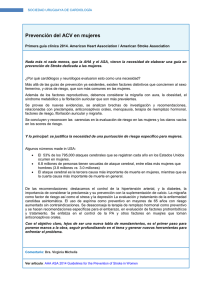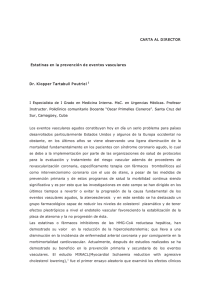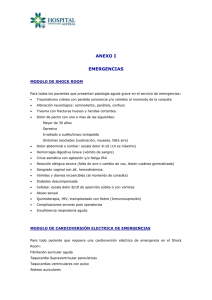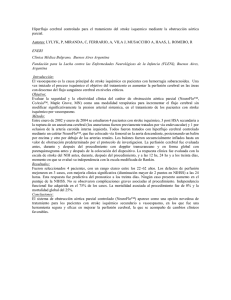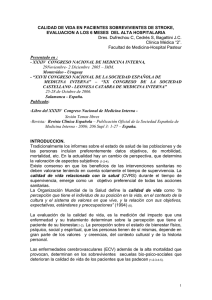Management of Acute Stroke Patients With Rapidly Resolving
Anuncio
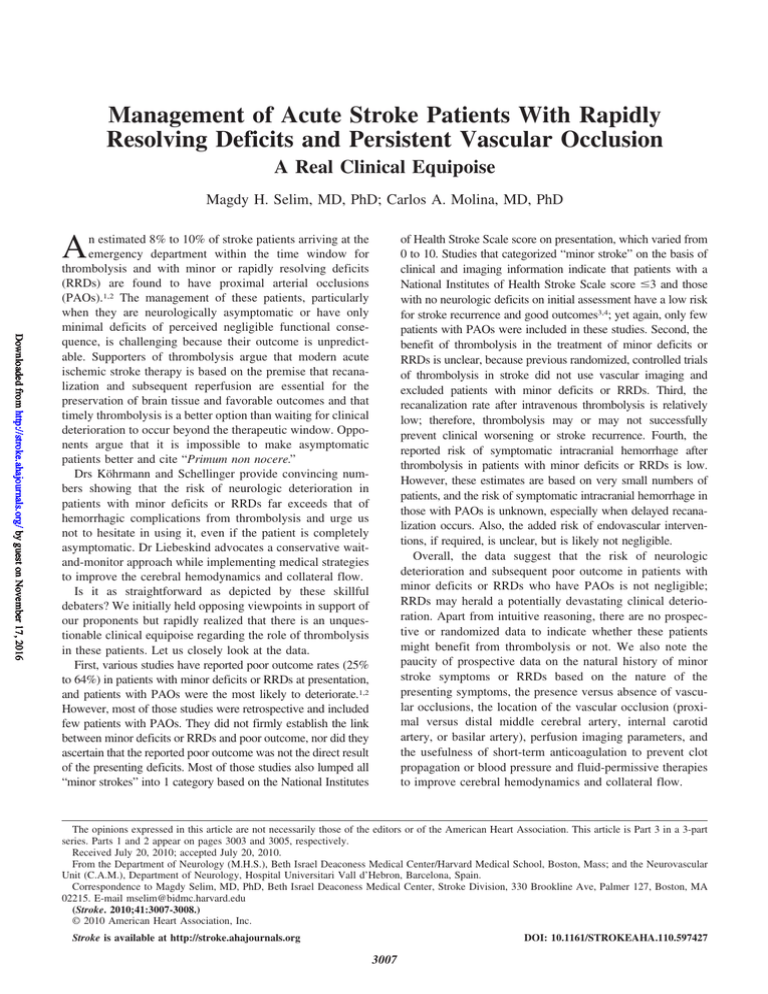
Management of Acute Stroke Patients With Rapidly Resolving Deficits and Persistent Vascular Occlusion A Real Clinical Equipoise Magdy H. Selim, MD, PhD; Carlos A. Molina, MD, PhD A Downloaded from http://stroke.ahajournals.org/ by guest on November 17, 2016 n estimated 8% to 10% of stroke patients arriving at the emergency department within the time window for thrombolysis and with minor or rapidly resolving deficits (RRDs) are found to have proximal arterial occlusions (PAOs).1,2 The management of these patients, particularly when they are neurologically asymptomatic or have only minimal deficits of perceived negligible functional consequence, is challenging because their outcome is unpredictable. Supporters of thrombolysis argue that modern acute ischemic stroke therapy is based on the premise that recanalization and subsequent reperfusion are essential for the preservation of brain tissue and favorable outcomes and that timely thrombolysis is a better option than waiting for clinical deterioration to occur beyond the therapeutic window. Opponents argue that it is impossible to make asymptomatic patients better and cite “Primum non nocere.” Drs Köhrmann and Schellinger provide convincing numbers showing that the risk of neurologic deterioration in patients with minor deficits or RRDs far exceeds that of hemorrhagic complications from thrombolysis and urge us not to hesitate in using it, even if the patient is completely asymptomatic. Dr Liebeskind advocates a conservative waitand-monitor approach while implementing medical strategies to improve the cerebral hemodynamics and collateral flow. Is it as straightforward as depicted by these skillful debaters? We initially held opposing viewpoints in support of our proponents but rapidly realized that there is an unquestionable clinical equipoise regarding the role of thrombolysis in these patients. Let us closely look at the data. First, various studies have reported poor outcome rates (25% to 64%) in patients with minor deficits or RRDs at presentation, and patients with PAOs were the most likely to deteriorate.1,2 However, most of those studies were retrospective and included few patients with PAOs. They did not firmly establish the link between minor deficits or RRDs and poor outcome, nor did they ascertain that the reported poor outcome was not the direct result of the presenting deficits. Most of those studies also lumped all “minor strokes” into 1 category based on the National Institutes of Health Stroke Scale score on presentation, which varied from 0 to 10. Studies that categorized “minor stroke” on the basis of clinical and imaging information indicate that patients with a National Institutes of Health Stroke Scale score ⱕ3 and those with no neurologic deficits on initial assessment have a low risk for stroke recurrence and good outcomes3,4; yet again, only few patients with PAOs were included in these studies. Second, the benefit of thrombolysis in the treatment of minor deficits or RRDs is unclear, because previous randomized, controlled trials of thrombolysis in stroke did not use vascular imaging and excluded patients with minor deficits or RRDs. Third, the recanalization rate after intravenous thrombolysis is relatively low; therefore, thrombolysis may or may not successfully prevent clinical worsening or stroke recurrence. Fourth, the reported risk of symptomatic intracranial hemorrhage after thrombolysis in patients with minor deficits or RRDs is low. However, these estimates are based on very small numbers of patients, and the risk of symptomatic intracranial hemorrhage in those with PAOs is unknown, especially when delayed recanalization occurs. Also, the added risk of endovascular interventions, if required, is unclear, but is likely not negligible. Overall, the data suggest that the risk of neurologic deterioration and subsequent poor outcome in patients with minor deficits or RRDs who have PAOs is not negligible; RRDs may herald a potentially devastating clinical deterioration. Apart from intuitive reasoning, there are no prospective or randomized data to indicate whether these patients might benefit from thrombolysis or not. We also note the paucity of prospective data on the natural history of minor stroke symptoms or RRDs based on the nature of the presenting symptoms, the presence versus absence of vascular occlusions, the location of the vascular occlusion (proximal versus distal middle cerebral artery, internal carotid artery, or basilar artery), perfusion imaging parameters, and the usefulness of short-term anticoagulation to prevent clot propagation or blood pressure and fluid-permissive therapies to improve cerebral hemodynamics and collateral flow. The opinions expressed in this article are not necessarily those of the editors or of the American Heart Association. This article is Part 3 in a 3-part series. Parts 1 and 2 appear on pages 3003 and 3005, respectively. Received July 20, 2010; accepted July 20, 2010. From the Department of Neurology (M.H.S.), Beth Israel Deaconess Medical Center/Harvard Medical School, Boston, Mass; and the Neurovascular Unit (C.A.M.), Department of Neurology, Hospital Universitari Vall d’Hebron, Barcelona, Spain. Correspondence to Magdy Selim, MD, PhD, Beth Israel Deaconess Medical Center, Stroke Division, 330 Brookline Ave, Palmer 127, Boston, MA 02215. E-mail [email protected] (Stroke. 2010;41:3007-3008.) © 2010 American Heart Association, Inc. Stroke is available at http://stroke.ahajournals.org DOI: 10.1161/STROKEAHA.110.597427 3007 3008 Stroke December 2010 Such studies are desperately needed to guide us on how best to treat these patients on an individual basis. We hope that the ongoing Platelet-Oriented Inhibition in New TIA and Minor Ischemic Stroke Trial and the planned Potential of rt-PA for Ischemic Strokes with Mild Symptoms Trial will help to answer the preceding questions. At present, we agree that it is not unreasonable to consider thrombolysis in patients with mild deficits of significant functional importance, such as aphasia or motor weakness, in the hope that it could restore function, but we remain divided over its use in completely asymptomatic patients. So, the controversy continues … Disclosures None. References 1. Nedeltchev K, Schwegler B, Haefeli T, Brekenfeld C, Gralla J, Fischer U, Arnold M, Remonda L, Schroth G, Mattle HP. Outcome of stroke with mild or rapidly improving symptoms. Stroke. 2007;38:2531–2535. 2. Coutts SB, O’Reilly C, Hill MD, Steffenhagen N, Poppe AY, Boyko MJ, Puetz V, Demchuk AM; Calgary CTA study group. Computed tomography and computed tomography angiography findings predict functional impairment in patients with minor stroke and transient ischaemic attack. Int J Stroke. 2009;4:448 – 453. 3. Coutts SB, Hill MD, Campos CR, Choi YB, Subramaniam S, Kosior JC, Demchuk AM; VISION Study Group. Recurrent events in transient ischemic attack and minor stroke: what events are happening and to which patients? Stroke. 2008;39:2461–2466. 4. Fischer U, Baumgartner A, Arnold M, Nedeltchev K, Gralla J, De Marchis GM, Kappeler L, Mono ML, Brekenfeld C, Schroth G, Mattle HP. What is a minor stroke? Stroke. 2010;41:661– 666. KEY WORDS: acute stroke 䡲 thrombolysis 䡲 thrombolytic RX TPA 䡲 transient ischemic attack 䡲 rapidly resolving deficits 䡲 TIA 䡲 Downloaded from http://stroke.ahajournals.org/ by guest on November 17, 2016 Management of Acute Stroke Patients With Rapidly Resolving Deficits and Persistent Vascular Occlusion: A Real Clinical Equipoise Magdy H. Selim and Carlos A. Molina Downloaded from http://stroke.ahajournals.org/ by guest on November 17, 2016 Stroke. 2010;41:3007-3008; originally published online October 28, 2010; doi: 10.1161/STROKEAHA.110.597427 Stroke is published by the American Heart Association, 7272 Greenville Avenue, Dallas, TX 75231 Copyright © 2010 American Heart Association, Inc. All rights reserved. Print ISSN: 0039-2499. Online ISSN: 1524-4628 The online version of this article, along with updated information and services, is located on the World Wide Web at: http://stroke.ahajournals.org/content/41/12/3007 Data Supplement (unedited) at: http://stroke.ahajournals.org/content/suppl/2012/02/26/STROKEAHA.110.597427.DC1.html http://stroke.ahajournals.org/content/suppl/2012/03/12/STROKEAHA.110.597427.DC2.html Permissions: Requests for permissions to reproduce figures, tables, or portions of articles originally published in Stroke can be obtained via RightsLink, a service of the Copyright Clearance Center, not the Editorial Office. Once the online version of the published article for which permission is being requested is located, click Request Permissions in the middle column of the Web page under Services. Further information about this process is available in the Permissions and Rights Question and Answer document. Reprints: Information about reprints can be found online at: http://www.lww.com/reprints Subscriptions: Information about subscribing to Stroke is online at: http://stroke.ahajournals.org//subscriptions/ Tratamiento de pacientes con ictus agudo que presentan déficit de resolución rápida y una oclusión vascular persistente Un verdadero equilibrio clínico Magdy H. Selim, MD, PhD; Carlos A. Molina, MD, PhD S e estima que en un 8% a 10% de los pacientes con ictus que llegan al servicio de urgencias dentro de la ventana temporal adecuada para la trombólisis y presentan déficit menores o déficit de resolución rápida (DRR) se identifican oclusiones arteriales proximales (OAP)1,2. El tratamiento de estos pacientes, sobre todo cuando están neurológicamente asintomáticos o tienen tan sólo déficit mínimos con unas consecuencias funcionales que se perciben como desdeñables, constituye un verdadero reto, ya que su evolución es impredecible. Los defensores de la trombólisis argumentan que el tratamiento moderno del ictus isquémico agudo se basa en la premisa de que la recanalización y posterior reperfusión son esenciales para la preservación del tejido cerebral y la obtención de un resultado favorable, y de que una trombólisis aplicada de forma temprana es una opción mejor que la de esperar a que se produzca un deterioro clínico cuando ya se ha superado la ventana terapéutica. Quienes se oponen a ella plantean que es imposible hacer que un paciente asintomático mejore y citan el aforismo de “Primum non nocere”. Los Drs. Köhrmann y Schellinger presentan cifras convincentes que indican que el riesgo de deterioro neurológico en los pacientes con déficit menores o DRR es muy superior al de las complicaciones hemorrágicas de la trombólisis y nos recomiendan no dudar en utilizarla, aun cuando el paciente esté totalmente asintomático. El Dr. Liebeskind defiende un enfoque conservador de espera y vigilancia, al tiempo que se aplican estrategias médicas para mejorar la hemodinámica cerebral y el flujo colateral. ¿Es la cuestión tan sencilla como la dibujan estos expertos en su controversia? Inicialmente tuvimos opiniones contrapuestas en cuanto a respaldar una de estas opciones, pero rápidamente nos dimos cuenta de que hay un equilibrio clínico incuestionable en lo relativo al papel de la trombólisis en estos pacientes. Examinemos los datos con mayor detalle. En primer lugar, diversos estudios han descrito la mala evolución (25% a 64%) en pacientes con déficit menores o DRR en el momento de la presentación clínica inicial, y los pacientes con OAP fueron los que mostraron una mayor probabilidad de deterioro1,2. Sin embargo, la mayoría de estos estudios fueron retrospectivos e incluyeron a pocos pacientes con OAP. No se estableció claramente la relación entre los déficit menores o DRR y la mala evolución, ni se determinó que la mala evolución descrita no fuera consecuencia directa de los déficit existentes en la presentación inicial. Además, la mayor parte de esos estudios acumularon todos los “ictus menores” en una sola categoría, basándose en la puntuación de la National Institutes of Health Stroke Scale en el momento de la presentación inicial, que variaba entre 0 y 10. Los estudios que han clasificado los “ictus menores” en función de la información clínica y de exploraciones de imagen indican que los pacientes con una puntuación ≤ 3 en la National Institutes of Health Stroke Scale y los que no presentan déficit neurológicos en la evaluación inicial tienen un riesgo bajo de recurrencia del ictus y una buena evolución3,4; sin embargo, nuevamente, sólo hubo un número reducido de pacientes con OAP en estos estudios. En segundo lugar, el efecto beneficioso de la trombólisis en el tratamiento de los déficit menores o DRR no está claro, ya que en los ensayos controlados y aleatorizados previos de la trombólisis en el ictus no se utilizaron técnicas de diagnóstico por la imagen vascular y se excluyó a los pacientes con déficit menores o DRR. En tercer lugar, la tasa de recanalización tras la trombólisis intravenosa es relativamente baja; en consecuencia, la trombólisis puede conseguir prevenir o no el agravamiento clínico o la recurrencia del ictus. En cuarto lugar, el riesgo descrito de hemorragia intracraneal sintomática tras la trombólisis en pacientes con déficit menores o DRR es bajo. Sin embargo, estas estimaciones se basan en un número de pacientes muy bajo, y el Las opiniones expresadas en este artículo no son necesariamente las de los editores o las de la American Heart Association. Este artículo es la Parte 3 de una serie de 3 partes. Las partes 1 y 2 se encuentran en las páginas 3003 y 3005, respectivamente. Recibido el 20 de julio de 2010; aceptado el 20 de julio de 2010. Department of Neurology (M.H.S.), Beth Israel Deaconess Medical Center/Harvard Medical School, Boston, Mass; y Unidad Neurovascular (C.A.M.), Departamento de Neurología, Hospital Universitari Vall d’Hebron, Barcelona, España. Remitir la correspondencia a Magdy Selim, MD, PhD, Beth Israel Deaconess Medical Center, Stroke Division, 330 Brookline Ave, Palmer 127, Boston, MA 02215. E-mail [email protected] (Traducido del inglés: Management of Acute Stroke Patients With Rapidly Resolving Deficits and Persistent Vascular Occlusion. A Real Clinical Equipoise. Stroke, 2010;41:3007-3008.) © 2010 American Heart Association, Inc. Stroke está disponible en http://www.stroke.ahajournals.org 52 DOI: 10.1161/STROKEAHA.110.597427 Selim y cols. Tratamiento de pacientes con ictus agudo 53 riesgo de hemorragia intracraneal sintomática en los pacientes con OAP no se conoce, en especial cuando se produce una recanalización tardía. Además, el riesgo añadido de las intervenciones endovasculares, caso de que sean necesarias, no está claro, pero es probable que no sea desdeñable. Globalmente, los datos sugieren que el riesgo de deterioro neurológico y posterior evolución desfavorable en los pacientes con déficit menores o DRR que presentan una OAP no es en absoluto despreciable; los DRR pueden ser el anuncio de un deterioro clínico devastador. Aparte del razonamiento intuitivo, no hay datos prospectivos ni aleatorizados que indiquen si en estos pacientes puede obtenerse o no un efecto beneficioso con la trombólisis. Observamos también la escasez de datos prospectivos sobre la evolución natural de los síntomas de ictus menor o de los DRR en función del carácter de los síntomas de presentación, la presencia o ausencia de oclusiones vasculares, la localización de la oclusión vascular (proximal frente a distal en la arteria cerebral media, arteria carótida interna o arteria basilar), los parámetros de imagen de perfusión, y la utilidad de la anticoagulación a corto plazo para prevenir la propagación del coágulo o el tratamiento de la presión arterial o el uso de líquidos para mejorar la hemodinámica cerebral y el flujo colateral. Hay una necesidad acuciante de este tipo de estudios que nos orienten sobre la mejor forma de tratar a esos pacientes de forma individualizada. Es de esperar que el ensayo en curso Platelet-Oriented Inhibition in New TIA and Minor Ischemic Stroke Trial y el ensayo planificado Potential of rt-PA for Ischemic Strokes with Mild Symptoms Trial sean útiles para responder a esas preguntas. En la actualidad, estamos de acuerdo en que no deja de ser razonable considerar el uso de trombólisis en pacientes con déficit leves de importancia funcional significativa, como la afasia o la debilidad motora, con la esperanza de que pueda restablecerse la función, pero continuamos estando divididos por lo que respecta a su uso en pacientes totalmente asintomáticos. Así pues, la controversia continúa… Ninguna. Declaraciones Bibliografía 1. Nedeltchev K, Schwegler B, Haefeli T, Brekenfeld C, Gralla J, Fischer U, Arnold M, Remonda L, Schroth G, Mattle HP. Outcome of stroke with mild or rapidly improving symptoms. Stroke. 2007;38:2531–2535. 2. Coutts SB, O’Reilly C, Hill MD, Steffenhagen N, Poppe AY, Boyko MJ, Puetz V, Demchuk AM; Calgary CTA study group. Computed tomography and computed tomography angiography findings predict functional impairment in patients with minor stroke and transient ischaemic attack. Int J Stroke. 2009;4:448 – 453. 3. Coutts SB, Hill MD, Campos CR, Choi YB, Subramaniam S, Kosior JC, Demchuk AM; VISION Study Group. Recurrent events in transient ischemic attack and minor stroke: what events are happening and to which patients? Stroke. 2008;39:2461–2466. 4. Fischer U, Baumgartner A, Arnold M, Nedeltchev K, Gralla J, De Marchis GM, Kappeler L, Mono ML, Brekenfeld C, Schroth G, Mattle HP. What is a minor stroke? Stroke. 2010;41:661– 666. Palabras Clave: acute stroke n thrombolysis n thrombolytic RX n TIA n tPA n transient ischemic attack n rapidly resolving deficits
